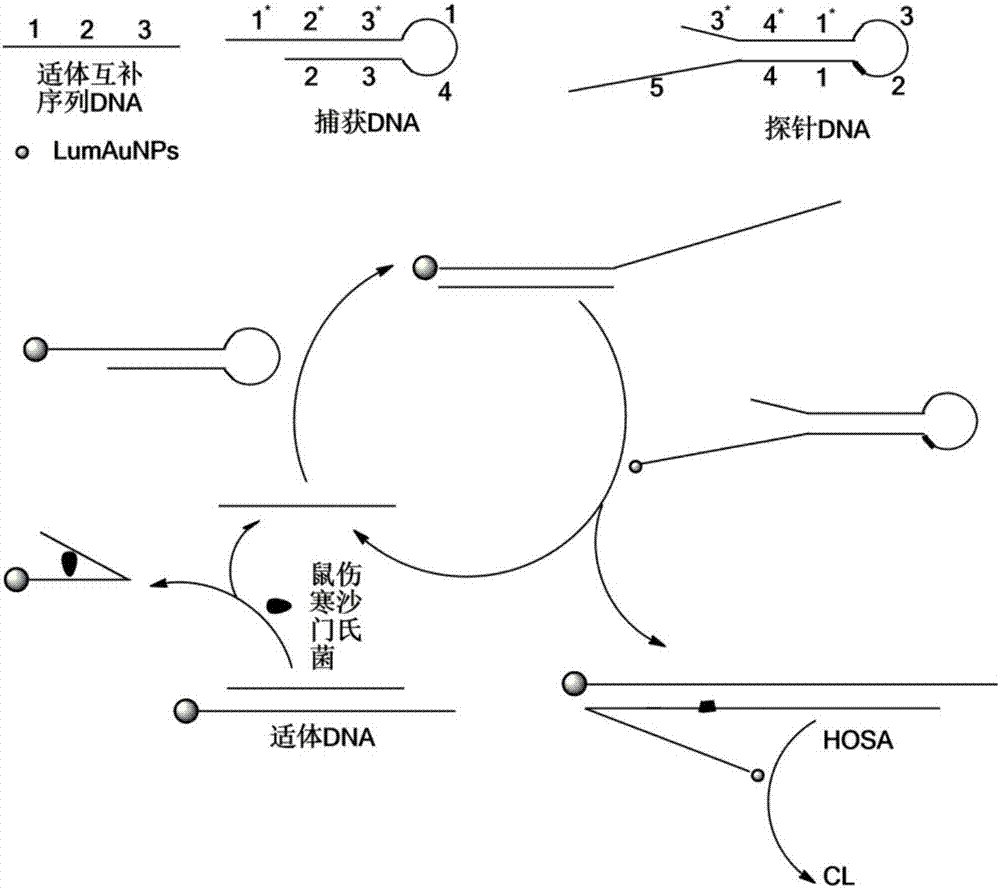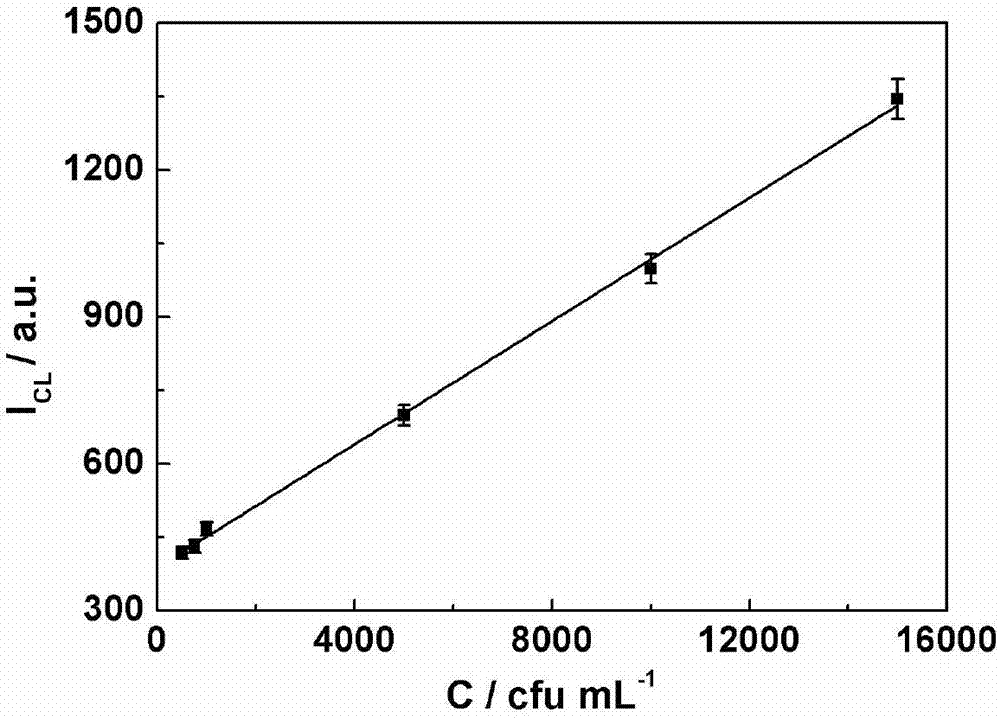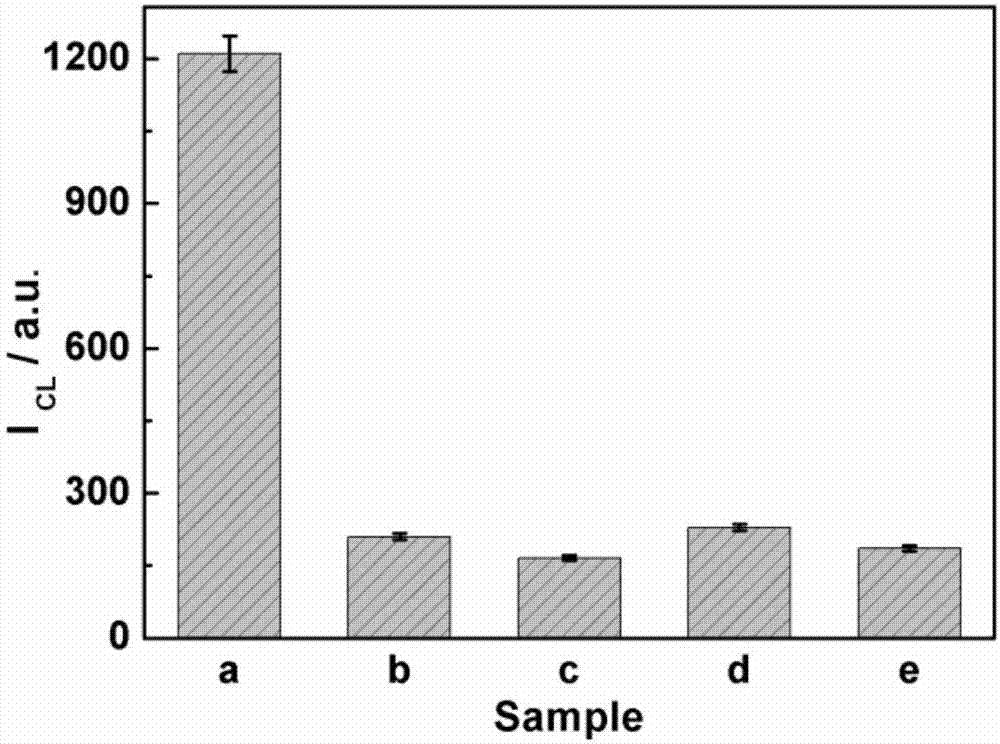Method for detecting Salmonella typhimurium
A technology for Salmonella and Typhimurium, which is applied in the field of analytical chemistry and can solve the problems of sensitivity limitation and high background signal
- Summary
- Abstract
- Description
- Claims
- Application Information
AI Technical Summary
Problems solved by technology
Method used
Image
Examples
example 1
[0041] Example 1: A method for detecting Salmonella typhimurium
[0042] 1. Experimental part
[0043] 1.1 Instruments and reagents
[0044] 1.1.1 Instruments and equipment
[0045] DHG blast drying oven (Shanzhi Instrument Equipment Co., Ltd., Shanghai); AR224CN Ohaus analytical balance (Qingdao Zhonghe Hengxin Electronics Co., Ltd., Qingdao); THZ constant temperature oscillation box (Jiayuan Xingye Technology Co., Ltd., Beijing) ; RFL-1 ultra-weak chemiluminescence detector (Ruimai Analytical Instrument Co., Ltd., Xi'an); Anke-TGL-16C Feiweng brand high-speed centrifuge (Anting Scientific Instrument Factory, Shanghai).
[0046] 1.1.2 Reagents
[0047] 1-(3-Dimethylaminopropyl)-3-ethylcarbodiimide hydrochloride (EDC), N-hydroxysuccinimide (NHS), chloroauric acid (HAuCl 4 ) was purchased from Sigma; the carboxyl magnetic beads with a particle size of 0.5 μm and a concentration of 10 mg / mL were purchased from Tianjin Beisi Le Chromatography Technology Development Center; Lu...
example 2
[0071] Example 2: Sensitivity comparison of methods
[0072] Using non-mismatched probe DNA:
[0073] 5’-AGA TGA GTG GAT TAA ACC CGG TAG ACT CAT CTT TGA ATA ACT ACC GGGTTT AAT CCC ACG AGA TAC TGT TCC-SH-3’;
[0074] One mismatch base probe DNA:
[0075]5’-AGA TGA GTG GAT TAA ACC CGG TAG ACT CAT CTT TGA ATA AGT ACC GGGTTT AAT CCC ACG AGA TAC TGT TCC-SH-3’;
[0076] Two mismatch base probe DNA:
[0077] 5'-AGA TGA GTG GAT TAA ACC CGG TAG ACT CAT CTT TGA ATA TGT ACC GGGTTT AAT CCC ACG AGA TAC TGT TCC-SH-3' instead of probe DNA, other steps are the same, according to the method of the present invention for Salmonella typhimurium Detection, the detection limit of determination is 10000cfu / mL, 4500cfu / mL and 1980cfu / mL respectively, all of which are higher than the detection limit of three mismatched base probe DNA. It shows that a method for detecting Salmonella typhimurium proposed by the present invention has high sensitivity.
example 3
[0078] Example 3: Impact of mismatches on the system
[0079] In order to weaken the background signal and improve the signal-to-noise ratio, the influence of the catalytic hairpin self-assembly technology and the mismatch catalytic hairpin self-assembly technology of this application on the experiment was explored. In the catalytic hairpin self-assembly technology, the capture DNA adopts the above-mentioned sequence, and the probe DNA is a non-mismatched probe DNA; in this application, the DNA sequence in the 3' end 2 region of the probe DNA is mismatched by three bases, that is, the detection Needle DNA. Such as Figure 4 As shown, under the same conditions, when there is no Salmonella typhimurium, the chemiluminescence signal is 373 when the non-mismatched probe DNA is used, while the signal is only 147 when the probe DNA is used. Although the signal of the hairpin self-assembly technique was higher than that of the mismatch-catalyzed hairpin self-assembly technique under...
PUM
| Property | Measurement | Unit |
|---|---|---|
| particle diameter | aaaaa | aaaaa |
Abstract
Description
Claims
Application Information
 Login to View More
Login to View More - R&D
- Intellectual Property
- Life Sciences
- Materials
- Tech Scout
- Unparalleled Data Quality
- Higher Quality Content
- 60% Fewer Hallucinations
Browse by: Latest US Patents, China's latest patents, Technical Efficacy Thesaurus, Application Domain, Technology Topic, Popular Technical Reports.
© 2025 PatSnap. All rights reserved.Legal|Privacy policy|Modern Slavery Act Transparency Statement|Sitemap|About US| Contact US: help@patsnap.com



